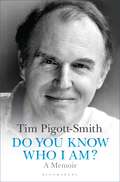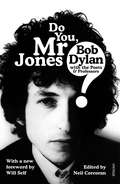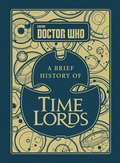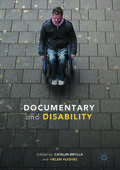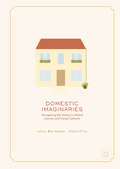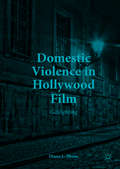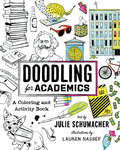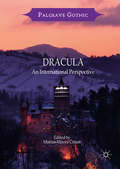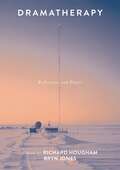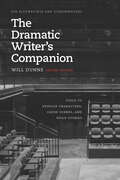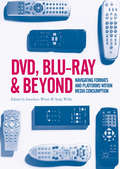- Table View
- List View
Divine Work, Japanese Colonial Cinema and its Legacy (Topics and Issues in National Cinema)
by Kate Taylor-JonesFor many East Asian nations, cinema and Japanese Imperialism arrived within a few years of each other. Exploring topics such as landscape, gender, modernity and military recruitment, this study details how the respective national cinemas of Japan's territories struggled under, but also engaged with, the Japanese Imperial structures. Japan was ostensibly committed to an ethos of pan-Asianism and this study explores how this sense of the transnational was conveyed cinematically across the occupied lands. Taylor-Jones traces how cinema in the region post-1945 needs to be understood not only in terms of past colonial relationships, but also in relation to how the post-colonial has engaged with shifting political alliances, the opportunities for technological advancement and knowledge, the promise of larger consumer markets, and specific historical conditions of each decade.
Divine Work, Japanese Colonial Cinema and its Legacy (Topics and Issues in National Cinema)
by Kate Taylor-JonesFor many East Asian nations, cinema and Japanese Imperialism arrived within a few years of each other. Exploring topics such as landscape, gender, modernity and military recruitment, this study details how the respective national cinemas of Japan's territories struggled under, but also engaged with, the Japanese Imperial structures. Japan was ostensibly committed to an ethos of pan-Asianism and this study explores how this sense of the transnational was conveyed cinematically across the occupied lands. Taylor-Jones traces how cinema in the region post-1945 needs to be understood not only in terms of past colonial relationships, but also in relation to how the post-colonial has engaged with shifting political alliances, the opportunities for technological advancement and knowledge, the promise of larger consumer markets, and specific historical conditions of each decade.
Do You Know Who I Am?: A Memoir
by Mr Tim Pigott-SmithFrom his appearance as Ronald Merrick in the television adaptation of The Jewel in the Crown to his recent role in the hit play King Charles III, Tim Pigott-Smith has been recognised as one of Britain's most loved contemporary actors. On stage his work encompassed the Bristol Old Vic, Royal Shakespeare Company, National Theatre, West End and Broadway. He acted with Jeremy Irons, Charles Dance, Anthony Hopkins, Michael Caine, Peggy Ashcroft and Judi Dench and collaborated with a host of famous directors, from his late friend Howard Davies, to John Huston and Peter Hall. In his memoir, Do You Know Who I Am?, Pigott-Smith describes the actor's craft with witty anecdotes and fascinating insight. He recalls his childhood and early beginnings in the paint shop at the RSC Stratford, the life of a jobbing actor in 1960s and 70s London, strange meetings with glamorous Hollywood producers, filming a football match with Pelé in Hungary, the epic Indian saga of The Jewel in the Crown and more recent projects such as Mike Bartlett's King Charles III, first performed at the Almeida Theatre and later transferred to Wyndham's Theatre in the West End, Broadway and to film. What is the story of Judi Dench and the black glove? What was it like to visit Michael Caine's LA mansion? How does one produce the character of the complex and unforgettable Corporal Merrick? Humorously written, warm, engaging and accompanied by black and white photographs, Do You Know Who I Am? is an entertaining memoir from one of our great acting talents. Tim Pigott-Smith died in April 2017, shortly before this book was published, having passed final proofs for press.
Do You Mr Jones?: Bob Dylan with the Poets and Professors
by Neil CorcoranIn 2016, Bob Dylan received the Nobel Prize in Literature ‘for having created new poetic expressions within the great American song tradition’. This collection of essays by leading poets and critics – with a new foreword by Will Self – examines Dylan’s poetic genius, as well as his astounding cultural influence over the decades.‘From Orpheus to Faiz, song and poetry have been closely linked. Dylan is the brilliant inheritor of the bardic tradition’ Salman Rushdie‘The most significant Western popular artist in any form or medium of the past sixty years’ Will Self‘For fifty and some years he has bent, coaxed, teased and persuaded words into lyric and narrative shapes that are at once extraordinary and inevitable’ Andrew Motion‘His haunting music and lyrics have always seemed, in the deepest sense, literary’ Joyce Carol Oates‘There is something inevitable about Bob Dylan… A storyteller pulling out all the stops – metaphor, allegory, repetition, precise detail… His virtue is in his style, his attitude, his disposition to the world’ Simon Armitage
Doctor Who: A Brief History of Time Lords
by Steve TribeThe Time Lords are an immensely civilised, and immensely powerful, race. Yet we know very little about them, save that they can live forever (barring accidents) and possess the secrets of space and time travel. Their history has been shrouded in myth and mystery. Until now.A Brief History of Time Lords unlocks the secrets of this ancient, legendary alien race - a civilisation that inflicted some of its most notorious renegades and criminals on the universe, but was also the benevolent power that rid the cosmos of its most fearsome enemies. Drawn from the ancient records of Gallifrey, and handed down from generation to generation, this remarkable book reveals the Time Lords in all of their guises: pioneers and power-mad conspirators, time-travellers and tyrants, creators and destroyers. Be careful who you share it with.
Documentary and Disability
by Catalin Brylla Helen HughesThis edited collection of contributions from media scholars, film practitioners and film historians connects the vibrant fields of documentary and disability studies. Documentary film has not only played an historical role in the social construction of disability but continues to be a strong force for expression, inclusion and activism. Offering essays on the interpretation and conception of a wide variety of documentary formats, Documentary and Disability reveals a rich set of resources on subjects as diverse as Thomas Quasthoff’s opera performances, Tourette syndrome in the developing world, queer approaches to sexual functionality, Channel 4 disability sports broadcasting, the political meaning of cochlear implant activation, and Christoph’s Schlingensief’s celebrated Freakstars 3000.
Domestic Imaginaries: Navigating the Home in Global Literary and Visual Cultures
by Bex Harper Hollie PriceThis book examines representations of home in literary and visual cultures in the 20th and 21st centuries. The collection brings together scholars working on literature, film, and photography with the aim of showcasing new research in a burgeoning field focusing on representations of domesticity. The chapters span a diverse range of contexts from across the world and use a variety of approaches to exploring representations of home including studies of space, material culture, sexuality, gender, multiculturalism, diaspora, memory and archival practice. They include explorations of the Finnish Suburban home on film, home and the diasporic imagination in Chinese Canadian women’s writing and the archiving practices and photographs used to document the homes of two gay writers from Australia and New Zealand. By bringing together this range of approaches and subjects, the book explores domestic imaginaries as part of a multi-faceted, mutable and amorphous conception of home in a modern, world context. This collection therefore seeks to further studies of home by investigating how the page, screen and photograph have constructed domestic imaginaries – experiencing, critiquing, reconfiguring and archiving home – in a global age.
Domestic Imaginaries: Navigating the Home in Global Literary and Visual Cultures
by Bex Harper Hollie PriceThis book examines representations of home in literary and visual cultures in the 20th and 21st centuries. The collection brings together scholars working on literature, film, and photography with the aim of showcasing new research in a burgeoning field focusing on representations of domesticity. The chapters span a diverse range of contexts from across the world and use a variety of approaches to exploring representations of home including studies of space, material culture, sexuality, gender, multiculturalism, diaspora, memory and archival practice. They include explorations of the Finnish Suburban home on film, home and the diasporic imagination in Chinese Canadian women’s writing and the archiving practices and photographs used to document the homes of two gay writers from Australia and New Zealand. By bringing together this range of approaches and subjects, the book explores domestic imaginaries as part of a multi-faceted, mutable and amorphous conception of home in a modern, world context. This collection therefore seeks to further studies of home by investigating how the page, screen and photograph have constructed domestic imaginaries – experiencing, critiquing, reconfiguring and archiving home – in a global age.
Domestic Violence in Hollywood Film: Gaslighting (PDF)
by Diane L. ShoosThis is the first book to critically examine Hollywood films that focus on male partner violence against women. These films include Gaslight, Sleeping with the Enemy, What’s Love Got to Do with It, Dolores Claiborne, Enough, and Safe Haven. Shaped by the contexts of postfeminism, domestic abuse post-awareness, and familiar genre conventions, these films engage in ideological “gaslighting” that reaffirms our preconceived ideas about men as abusers, women as victims, and the racial and class politics of domestic violence. While the films purport to condemn abuse and empower abused women, this study proposes that they tacitly reinforce the very attitudes that we believe we no longer tolerate. Shoos argues that films like these limit not only popular understanding but also social and institutional interventions.
Don't Look Now (Devil's Advocates)
by Jessica GildersleeveNicolas Roeg's Don't Look Now (1973) has been called "a ghost story for adults." Certainly, in contrast to the more explicitly violent and bloodthirsty horror films of the 1970s, Don't Look Now seems of an entirely different order. Yet this supernaturally inflected tale of a child's accidental drowning, and her parents' desperate simultaneous recoil from her death and pursuit of her ghost, Don't Look Now is horrific at every turn. This book argues for it as a particular kind of horror film, one which depends utterly on the narrative of trauma—on the horror of unknowing, of seeing too late, and of the failures of paternal authority and responsibility. Jessica Gildersleeve positions Don't Look Now within a discourse of midcentury anxiety narratives primarily existing in literary texts. In this context, it represents a cross over or a hinge between literature and film of the 1970s, and the ways in which the women's ghost story or uncanny story turns the horror film into a cultural commentary on the failures of the modern family.
Doodling for Academics: A Coloring and Activity Book (Chicago Guides to Academic Life)
by Julie SchumacherTo an outsider, working as a university professor might seem like a dream: summers off, a few hours of class each week, an exchange of ideas with brilliant colleagues, books and late afternoon lattes. . . . Who wouldn’t envy that life? But those in the trenches of academe are well acquainted with the professoriate’s dark underside: the hierarchies and pseudo-political power plays, the peculiar colleagues, the over-parented students, the stacks of essays that need to be graded ASAP. No one understands this world better than novelist Julie Schumacher, who here provides a bitingly funny distraction designed to help you survive life in higher education without losing your mind. Sardonic yet shrewdly insightful, Doodling for Academics offers the perfect cognitive relief for the thousands of faculty and grad students whose mentors and loved ones failed to steer them toward more reasonable or lucrative fields. Through forty pages of original illustrations and activities—from coloring to paper dolls to mad libs—this book traces the arc of a typical day on campus. Get a peek inside the enigma of the student brain. Imagine a utopian faculty meeting. Navigate the red tape maze of university administration. With the help of hilarious illustrations by Lauren Nassef, Schumacher infuses the world of campus greens and university quads with cutting wit, immersing you deep into the weirdly creative challenges of university life. Offering a satirical interactive experience for scholars, the combination of humor and activities in this book will bring academia into entertaining relief, making it the perfect gift for your colleagues, advisors, or newly minted graduates.
Douglas Sirk, Aesthetic Modernism and the Culture of Modernity
by Victoria L. EvansThe first truly interdisciplinary analysis to link Douglas Sirk's striking visual aesthetic to key movements in twentieth century art and architecture, this book reveals how the exaggerated artifice of Sirk’s formal style emerged from his detailed understanding of the artistic debates that raged in 1920s Europe and the post-war United States. With detailed case studies of Final Chord and All That Heaven Allows, Victoria Evans demonstrates how Sirk attempted to dissolve the boundaries of cinema by assimilating elements of avant-garde art, architecture and design into the colour, composition and setting of many of his most well-known films. Treating Sirk’s oeuvre as a continuum between his German and American periods, Evans argues that his mise-en-scène was the result of an interdisciplinary, transnational dialogue, and illuminates the broader cultural context in which his films appeared by establishing links between archival documents, Modernist manifestos and the philosophical writings of his peers.
Douglas Sirk, Aesthetic Modernism and the Culture of Modernity (Edinburgh University Press)
by Victoria L. EvansThe first truly interdisciplinary analysis to link Douglas Sirk's striking visual aesthetic to key movements in twentieth century art and architecture, this book reveals how the exaggerated artifice of Sirk’s formal style emerged from his detailed understanding of the artistic debates that raged in 1920s Europe and the post-war United States. With detailed case studies of Final Chord and All That Heaven Allows, Victoria Evans demonstrates how Sirk attempted to dissolve the boundaries of cinema by assimilating elements of avant-garde art, architecture and design into the colour, composition and setting of many of his most well-known films. Treating Sirk’s oeuvre as a continuum between his German and American periods, Evans argues that his mise-en-scène was the result of an interdisciplinary, transnational dialogue, and illuminates the broader cultural context in which his films appeared by establishing links between archival documents, Modernist manifestos and the philosophical writings of his peers.
Dracula: An International Perspective
by Marius-Mircea CrișanThis volume analyses the role of Bram Stoker’s Dracula and its sequels in the evolution of the Gothic. As well as the transformation of the Gothic location—from castles, cemeteries and churches to the modern urban gothic—this volume explores the evolution of the undead considering a range of media from the 19th century protagonist to sympathetic contemporary vampires of teen Gothic. Based on an interdisciplinary approach (literature, tourism, and film), the book argues that the development of the Dracula myth is the result of complex international influences and cultural interactions. Offering a multifarious perspective, this volume is a reference work that will be useful to both academic and general readers.
Dracula: An International Perspective (PDF)
by Marius-Mircea CrișanThis volume analyses the role of Bram Stoker’s Dracula and its sequels in the evolution of the Gothic. As well as the transformation of the Gothic location—from castles, cemeteries and churches to the modern urban gothic—this volume explores the evolution of the undead considering a range of media from the 19th century protagonist to sympathetic contemporary vampires of teen Gothic. Based on an interdisciplinary approach (literature, tourism, and film), the book argues that the development of the Dracula myth is the result of complex international influences and cultural interactions. Offering a multifarious perspective, this volume is a reference work that will be useful to both academic and general readers.
Dramatherapy: Reflections and Praxis
by Bryn Jones Richard HoughamA critical and cohesive collection of interdisciplinary perspectives on Dramatherapy as it is being practiced, developed and advanced today. Unpicking the relationship between drama and therapy, exploring its key philosophies and practices, and examining its efficacy, the text is a crucial resource for students and practitioners in a growing field.
The Dramatic Writer's Companion, Second Edition: Tools to Develop Characters, Cause Scenes, and Build Stories (Chicago Guides to Writing, Editing, and Publishing)
by Will DunneIn just eight years, The Dramatic Writer’s Companion has become a classic among playwrights and screenwriters. Thousands have used its self-contained character, scene, and story exercises to spark creativity, hone their writing, and improve their scripts. Having spent decades working with dramatists to refine and expand their existing plays and screenplays, Dunne effortlessly blends condensed dramatic theory with specific action steps—over sixty workshop-tested exercises that can be adapted to virtually any individual writing process and dramatic script. Dunne’s in-depth method is both instinctual and intellectual, allowing writers to discover new actions for their characters and new directions for their stories. The exercises can be used by those just starting the writing process and by those who have scripts already in development. With each exercise rooted in real-life issues from Dunne’s workshops, readers of this companion will find the combined experiences of more than fifteen hundred workshops in a single guide. This second edition is fully aligned with a brand-new companion book, Character, Scene, and Story, which offers forty-two additional activities to help writers more fully develop their scripts. The two books include cross-references between related exercises, though each volume can also stand alone. No ordinary guide to plotting, this handbook centers on the principle that character is key. “The character is not something added to the scene or to the story,” writes Dunne. “Rather, the character is the scene. The character is the story.” With this new edition, Dunne’s remarkable creative method will continue to be the go-to source for anyone hoping to take their story to the stage.
The Dramatic Writer's Companion, Second Edition: Tools to Develop Characters, Cause Scenes, and Build Stories (Chicago Guides to Writing, Editing, and Publishing)
by Will DunneIn just eight years, The Dramatic Writer’s Companion has become a classic among playwrights and screenwriters. Thousands have used its self-contained character, scene, and story exercises to spark creativity, hone their writing, and improve their scripts. Having spent decades working with dramatists to refine and expand their existing plays and screenplays, Dunne effortlessly blends condensed dramatic theory with specific action steps—over sixty workshop-tested exercises that can be adapted to virtually any individual writing process and dramatic script. Dunne’s in-depth method is both instinctual and intellectual, allowing writers to discover new actions for their characters and new directions for their stories. The exercises can be used by those just starting the writing process and by those who have scripts already in development. With each exercise rooted in real-life issues from Dunne’s workshops, readers of this companion will find the combined experiences of more than fifteen hundred workshops in a single guide. This second edition is fully aligned with a brand-new companion book, Character, Scene, and Story, which offers forty-two additional activities to help writers more fully develop their scripts. The two books include cross-references between related exercises, though each volume can also stand alone. No ordinary guide to plotting, this handbook centers on the principle that character is key. “The character is not something added to the scene or to the story,” writes Dunne. “Rather, the character is the scene. The character is the story.” With this new edition, Dunne’s remarkable creative method will continue to be the go-to source for anyone hoping to take their story to the stage.
The Dramatic Writer's Companion, Second Edition: Tools to Develop Characters, Cause Scenes, and Build Stories (Chicago Guides to Writing, Editing, and Publishing)
by Will DunneIn just eight years, The Dramatic Writer’s Companion has become a classic among playwrights and screenwriters. Thousands have used its self-contained character, scene, and story exercises to spark creativity, hone their writing, and improve their scripts. Having spent decades working with dramatists to refine and expand their existing plays and screenplays, Dunne effortlessly blends condensed dramatic theory with specific action steps—over sixty workshop-tested exercises that can be adapted to virtually any individual writing process and dramatic script. Dunne’s in-depth method is both instinctual and intellectual, allowing writers to discover new actions for their characters and new directions for their stories. The exercises can be used by those just starting the writing process and by those who have scripts already in development. With each exercise rooted in real-life issues from Dunne’s workshops, readers of this companion will find the combined experiences of more than fifteen hundred workshops in a single guide. This second edition is fully aligned with a brand-new companion book, Character, Scene, and Story, which offers forty-two additional activities to help writers more fully develop their scripts. The two books include cross-references between related exercises, though each volume can also stand alone. No ordinary guide to plotting, this handbook centers on the principle that character is key. “The character is not something added to the scene or to the story,” writes Dunne. “Rather, the character is the scene. The character is the story.” With this new edition, Dunne’s remarkable creative method will continue to be the go-to source for anyone hoping to take their story to the stage.
The Dramatic Writer's Companion, Second Edition: Tools to Develop Characters, Cause Scenes, and Build Stories (Chicago Guides to Writing, Editing, and Publishing)
by Will DunneIn just eight years, The Dramatic Writer’s Companion has become a classic among playwrights and screenwriters. Thousands have used its self-contained character, scene, and story exercises to spark creativity, hone their writing, and improve their scripts. Having spent decades working with dramatists to refine and expand their existing plays and screenplays, Dunne effortlessly blends condensed dramatic theory with specific action steps—over sixty workshop-tested exercises that can be adapted to virtually any individual writing process and dramatic script. Dunne’s in-depth method is both instinctual and intellectual, allowing writers to discover new actions for their characters and new directions for their stories. The exercises can be used by those just starting the writing process and by those who have scripts already in development. With each exercise rooted in real-life issues from Dunne’s workshops, readers of this companion will find the combined experiences of more than fifteen hundred workshops in a single guide. This second edition is fully aligned with a brand-new companion book, Character, Scene, and Story, which offers forty-two additional activities to help writers more fully develop their scripts. The two books include cross-references between related exercises, though each volume can also stand alone. No ordinary guide to plotting, this handbook centers on the principle that character is key. “The character is not something added to the scene or to the story,” writes Dunne. “Rather, the character is the scene. The character is the story.” With this new edition, Dunne’s remarkable creative method will continue to be the go-to source for anyone hoping to take their story to the stage.
Dunkirk
by Christopher NolanChristopher Nolan's previous films have reflected the uncertainties of the twentieth-first century. With Dunkirk, Nolan has gone back into the past and brought to life one of the momentous events of the twentieth-century - the evacuation of British troops from Dunkirk, telling the tale by land, sea, and sky.Dunkirk opens as hundreds of thousands of British and Allied troops are surrounded by enemy forces. Trapped on the beach with their backs to the sea, they face an impossible situation as the enemy closes in.The film features a prestigious cast, including Kenneth Branagh, Cillian Murphy, and newcomer Fionn Whitehead, with Mark Rylance and Tom Hardy.The screenplay is accompanied by a conversation about the film between Christopher Nolan and Jonathan Nolan,as well as selected storyboards.
DVD, Blu-ray and Beyond: Navigating Formats and Platforms within Media Consumption
by Jonathan Wroot Andy WillisThis book demonstrates, in contrast to statistics that show declining consumption of physical formats, that there has not been a mass shift towards purely digital media. Physical releases such as special editions, DVD box-sets and Blu-Rays are frequently promoted and sought out by consumers. And that past formats such as VHS, Laserdisc and HD-DVD make for sought-after collectible items. These trends are also found within particular genres and niche categories, such as documentary, education and independent film distribution. Through its case studies, this collection makes a distinctive and significant intervention in highlighting the ways in which the film industry has responded to rapidly changing markets. This volume, global in scope, will prove useful to those studying the distribution and exhibition of films, and the economics of the film industry around the world.
DVD, Blu-ray and Beyond: Navigating Formats and Platforms within Media Consumption
by Jonathan Wroot Andy WillisThis book demonstrates, in contrast to statistics that show declining consumption of physical formats, that there has not been a mass shift towards purely digital media. Physical releases such as special editions, DVD box-sets and Blu-Rays are frequently promoted and sought out by consumers. And that past formats such as VHS, Laserdisc and HD-DVD make for sought-after collectible items. These trends are also found within particular genres and niche categories, such as documentary, education and independent film distribution. Through its case studies, this collection makes a distinctive and significant intervention in highlighting the ways in which the film industry has responded to rapidly changing markets. This volume, global in scope, will prove useful to those studying the distribution and exhibition of films, and the economics of the film industry around the world.
Early Race Filmmaking in America (Routledge Advances in Film Studies)
by Barbara LupackThe early years of the twentieth century were a formative time in the long history of struggle for black representation. More than any other medium, movies reflected the tremendous changes occurring in American society. Unfortunately, since they drew heavily on the nineteenth-century theatrical conventions of blackface minstrelsy and the "Uncle Tom Show" traditions, early pictures persisted in casting blacks in demeaning and outrageous caricatures that marginalized and burlesqued them and emphasized their comic or servile behavior. By contrast, race films—that is, movies that were black-cast, black-oriented, and viewed primarily by black audiences in segregated theaters—attempted to counter the crude stereotyping and regressive representations by presenting more authentic racial portrayals. This volume examines race filmmaking from numerous perspectives. By reanimating a critical but neglected period of early cinema—the years between the turn-of-the-century and 1930, the end of the silent film era—it provides a fascinating look at the efforts of early race film pioneers and offers a vibrant portrait of race and racial representation in American film and culture.
Early Race Filmmaking in America (Routledge Advances in Film Studies)
by Barbara Tepa LupackThe early years of the twentieth century were a formative time in the long history of struggle for black representation. More than any other medium, movies reflected the tremendous changes occurring in American society. Unfortunately, since they drew heavily on the nineteenth-century theatrical conventions of blackface minstrelsy and the "Uncle Tom Show" traditions, early pictures persisted in casting blacks in demeaning and outrageous caricatures that marginalized and burlesqued them and emphasized their comic or servile behavior. By contrast, race films—that is, movies that were black-cast, black-oriented, and viewed primarily by black audiences in segregated theaters—attempted to counter the crude stereotyping and regressive representations by presenting more authentic racial portrayals. This volume examines race filmmaking from numerous perspectives. By reanimating a critical but neglected period of early cinema—the years between the turn-of-the-century and 1930, the end of the silent film era—it provides a fascinating look at the efforts of early race film pioneers and offers a vibrant portrait of race and racial representation in American film and culture.


